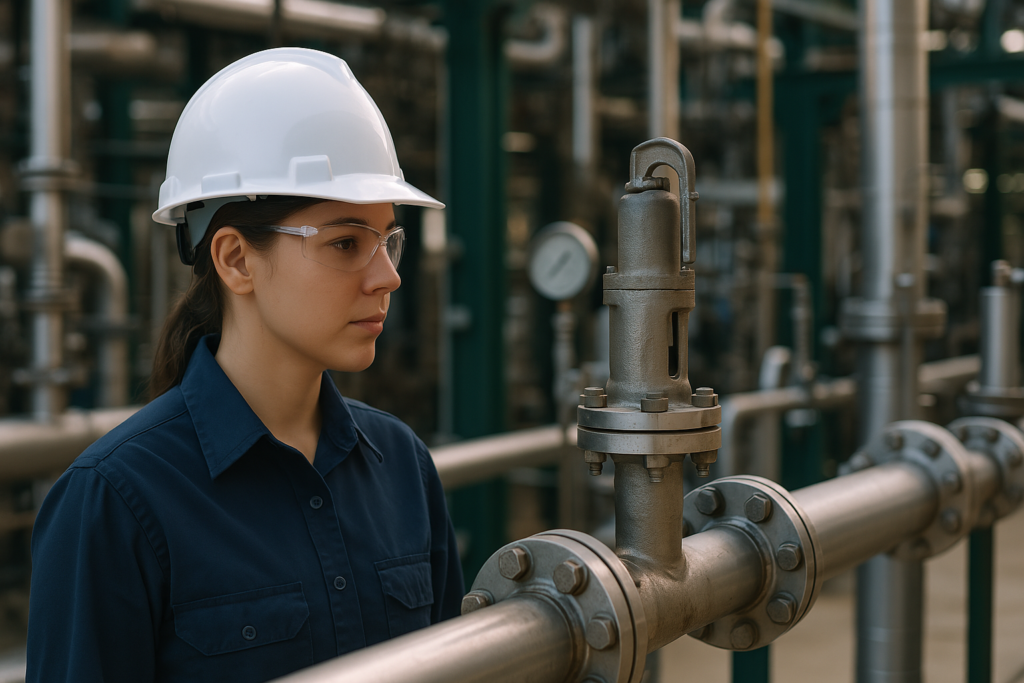In high-risk industries like oil and gas, chemicals, pharmaceuticals, or power generation, process safety isn’t just a compliance issue—it’s the foundation of operational integrity.
While most companies invest heavily in procedures and policies, the use of substandard quality equipment still lurks as a silent but deadly risk. Poor-quality valves, worn-out gaskets, non-certified pressure vessels, or counterfeit spare parts can lead to catastrophic failures, worker fatalities, environmental damage, and reputational collapse.
Let’s explore the role of process safety, how substandard equipment threatens plant operations, and what actions are needed to safeguard people, property, and the planet.
⚙️ What is Process Safety?
Process Safety refers to the systematic management of hazards associated with processes involving hazardous chemicals or high-risk operations, aiming to prevent fires, explosions, toxic releases, and equipment failures.
It’s different from occupational safety (like slips or falls) — process safety deals with large-scale events that can affect entire plants or communities.
🔍 Key Elements Include:
- Safe design and engineering of equipment
- Proper maintenance and inspection
- Control of process parameters (pressure, temperature, flow)
- Emergency planning and response
- Use of quality-assured components
🛠️ The Real Risk: Substandard Equipment in Industrial Plants
Substandard equipment refers to items that fail to meet industry specifications, standards (like ASME, API, ISO), or quality norms—often due to poor materials, counterfeit labeling, low-cost manufacturing, or improper certification.
👎 Where Substandard Equipment Sneaks In:
- Pressure relief valves with incorrect pressure settings
- Pipes with thinner-than-rated walls
- Gaskets that degrade under chemical exposure
- Non-flameproof electrical enclosures in hazardous zones
- Fake or forged documentation for pressure vessels or cranes
🚨 Real-World Consequences: When Equipment Fails
🔥 1. Explosion or Fire
A failed safety valve or corroded pipeline can cause overpressure, leading to explosions or fires in fuel or chemical storage areas.
Case Study: In 2005, the Texas City Refinery explosion (BP) killed 15 people—a key contributing factor was malfunctioning pressure-relief systems and deferred maintenance.
💧 2. Environmental Disaster
Leaks from substandard tanks or flanges can release hazardous chemicals into the environment—polluting water, soil, and air.
Inadequate sealing caused a major oil spill in the Niger Delta, destroying aquatic ecosystems and livelihoods.
💸 3. Operational Downtime & Financial Loss
When a plant shuts down due to a faulty component, production halts, deadlines are missed, and contract penalties apply—leading to millions in losses.
⚖️ 4. Legal and Regulatory Repercussions
Using uncertified parts can violate OSHA, EPA, or international standards, resulting in legal actions, plant shutdowns, or license suspensions.
📉 Root Causes of Substandard Equipment in Plants
- Cost-cutting measures and procurement from unverified vendors
- Lack of quality control checks during purchase or installation
- Fake certifications or forged inspection reports
- Inadequate training of technical and procurement teams
- Poor inventory and asset tracking
✅ How to Prevent the Use of Substandard Equipment
🔒 1. Vendor Qualification & Auditing
- Source only from certified and vetted suppliers
- Conduct on-site audits for high-risk equipment providers
📋 2. Strict Procurement Protocols
- Define technical specifications clearly
- Verify material test certificates, MTCs, and calibration documents
🔍 3. Third-Party Inspections
- Engage independent inspection agencies (TÜV, DNV, Lloyd’s)
- Use non-destructive testing (NDT) to verify quality during commissioning
🧠 4. Training and Awareness
- Train procurement, maintenance, and operations staff to identify counterfeit or substandard parts
🗂️ 5. Digital Asset Management
- Use barcoding or RFID to track equipment life cycle and replacements
- Implement digital preventive maintenance (PM) schedules
🧠 Process Safety Culture: Beyond Compliance
True process safety isn’t achieved by documents—it’s built through a safety-first culture where quality, responsibility, and vigilance are core values.
That means:
- Empowering employees to report unsafe equipment
- Encouraging questions about quality or certification
- Holding all contractors, vendors, and internal teams accountable
🌍 Final Thoughts: Safety is Engineered, Not Assumed
In process industries, safety is not optional—it’s engineered into every bolt, valve, pipe, and system.
Using substandard equipment is like building a bridge with cracked steel—it may stand today, but collapse tomorrow.
Every nut and bolt matters. Every standard followed prevents disaster. Every quality check is a life saved.
So the next time a “cheaper part” is considered—ask yourself: Can your plant afford the real cost of failure?


Pingback: NEBOSH IGC Exam 101: Everything You Must Know